
Tibetan Buddhism is a form of Buddhism practiced in Tibet and Mongolia. It also has a sizable number of adherents in the areas surrounding the Himalayas, including the Indian regions of Ladakh, Sikkim, and Arunachal Pradesh, as well as Bhutan and Nepal. Smaller groups of practitioners can be found in Central Asia, Xinjiang, Inner Mongolia, and some regions of Russia, such as Tuva, Buryatia, and Kalmykia.

Padmasambhāva, also known as Guru Rinpoche and the Lotus from Oḍḍiyāna, was a tantric Buddhist Vajra master from India who taught Vajrayana in Tibet. According to some early Tibetan sources like the Testament of Ba, he came to Tibet in the 8th century and helped construct Samye Monastery, the first Buddhist monastery in Tibet. However, little is known about the actual historical figure other than his ties to Vajrayana and Indian Buddhism.
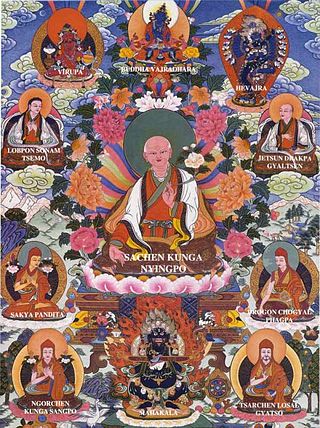
The Sakya school is one of four major schools of Tibetan Buddhism, the others being the Nyingma, Kagyu, and Gelug. It is one of the Red Hat Orders along with the Nyingma and Kagyu.

The Gelug is the newest of the four major schools of Tibetan Buddhism. It was founded by Je Tsongkhapa (1357–1419), a Tibetan philosopher, tantric yogi and lama and further expanded and developed by his disciples.
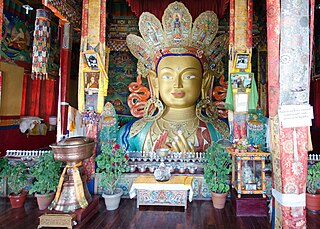
The vast majority of surviving Tibetan art created before the mid-20th century is religious, with the main forms being thangka, paintings on cloth, mostly in a technique described as gouache or distemper, Tibetan Buddhist wall paintings, and small statues in bronze, or large ones in clay, stucco or wood. They were commissioned by religious establishments or by pious individuals for use within the practice of Tibetan Buddhism and were manufactured in large workshops by monks and lay artists, who are mostly unknown. Various types of religious objects, such as the phurbu or ritual dagger, are finely made and lavishly decorated. Secular objects, in particular jewellery and textiles, were also made, with Chinese influences strong in the latter.

In Buddhism, wrathful deities or fierce deities are the fierce, wrathful or forceful forms of enlightened Buddhas, Bodhisattvas or Devas ; normally the same figure has other, peaceful, aspects as well. Because of their power to destroy the obstacles to enlightenment, they are also termed krodha-vighnantaka, "Wrathful onlookers on destroying obstacles". Wrathful deities are a notable feature of the iconography of Mahayana and Vajrayana Buddhism, especially in Tibetan art. These types of deities first appeared in India during the late 6th century, with its main source being the Yaksha imagery, and became a central feature of Indian Tantric Buddhism by the late 10th or early 11th century.
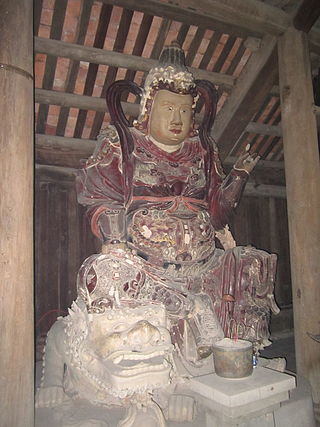
A dharmapāla is a type of wrathful god in Buddhism. The name means "dharma protector" in Sanskrit, and the dharmapālas are also known as the Defenders of the Justice (Dharma), or the Guardians of the Law. There are two kinds of dharmapala, Worldly Guardians (lokapala) and Wisdom Protectors (jnanapala). Only Wisdom Protectors are enlightened beings.

Yamāntaka or Vajrabhairava is the "destroyer of death" deity of Vajrayana Buddhism. Sometimes he is conceptualized as "conqueror of the lord of death". Of the several deities in the Buddhist pantheon named 'Yamāntaka', the most well known, also called as 'Vajrabhairava' belongs to the Anuttarayoga Tantra class of deities popular within the Gelug school of Tibetan Buddhism.
A yidam or iṣṭadevatā is a type of deity associated with tantric or Vajrayana Buddhism said to be manifestations of Buddhahood or enlightened mind. During personal meditation (sādhana) practice, the yogi identifies their own form, attributes and mind with those of a yidam for the purpose of transformation. Yidam is sometimes translated by the terms "meditational deity" or "tutelary deity". Examples of yidams include the meditation deities Chakrasamvara, Kalachakra, Hevajra, Yamantaka, and Vajrayogini, all of whom have a distinctive iconography, mandala, mantra, rites of invocation and practice.

Jamyang Khyentse Wangpo, also known by his tertön title, Pema Ösel Dongak Lingpa, was a renowned teacher, scholar and tertön of 19th-century Tibet. He was a leading figure in the Rimé movement.

Dzongsar Khyentse Chökyi Lodrö was a Tibetan lama, a master of many lineages, and a teacher of many of the major figures in 20th-century Tibetan Buddhism. Though he died in 1959 in Sikkim, and is not so well known in the West; he was a major proponent of the Rimé movement within Tibetan Buddhism, and had a profound influence on many of the Tibetan lamas teaching today.
Tertön is a term within Tibetan Buddhism meaning a person who is a discoverer of ancient hidden texts or terma. Many tertöns are considered to be incarnations of the twenty five main disciples of Padmasambhava, who foresaw a dark time in Tibet. He and his consort Yeshe Tsogyal hid teachings to be found in the future to benefit beings. A vast system of transmission lineages developed. Scriptures from the Nyingma school were updated by terma discoveries, and terma teachings have guided many Tibetan Bon and Buddhist practitioners.

A kartika or drigug is a small, crescent-shaped, hand-held ritual flaying knife used in the tantric ceremonies of Vajrayana Buddhism. The kartari is said to be "one of the quintessential attributes of the wrathful Tantric deities." It is commonly known as the "knife of the dakinis." Its shape is similar to the Inuit ulu or woman's knife, which is used for many things including cleaning skins.

Ayu Khandro, also known as Dorje Paldrön, was a Tibetan yogini, practitioner and terton of Tantric Buddhism in Eastern Tibet. An accomplished Dzogchen meditator, she is known for her extensive pilgrimages throughout Tibet, long periods of dark retreat practice, the gongter of the practice of the yidam Senge Dongma, various forms of Chöd, and her lifelong dedication to spiritual practice.

Vajrayoginī is a Tantric Buddhist female Buddha and a ḍākiṇī. The Vajrayogini cult dates back to the tenth and twelfth centuries. Vajrayoginī's essence is "great passion" (maharaga), a transcendent passion that is free of selfishness and illusion—she intensely works for the well-being of others and for the destruction of ego clinging. She is seen as being ideally suited for people with strong passions, providing the way to transform those passions into enlightened virtues.
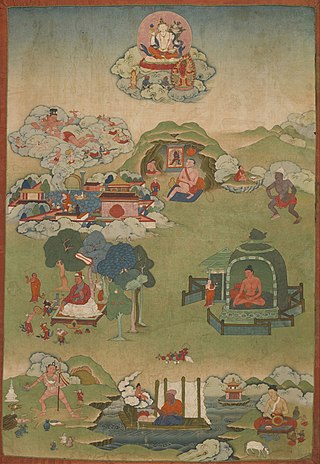
Tibetan tantric practice, also known as "the practice of secret mantra", and "tantric techniques", refers to the main tantric practices in Tibetan Buddhism. The great Rime scholar Jamgön Kongtrül refers to this as "the Process of Meditation in the Indestructible Way of Secret Mantra" and also as "the way of mantra," "way of method" and "the secret way" in his Treasury of Knowledge. These Vajrayāna Buddhist practices are mainly drawn from the Buddhist tantras and are generally not found in "common" Mahayana. These practices are seen by Tibetan Buddhists as the fastest and most powerful path to Buddhahood.
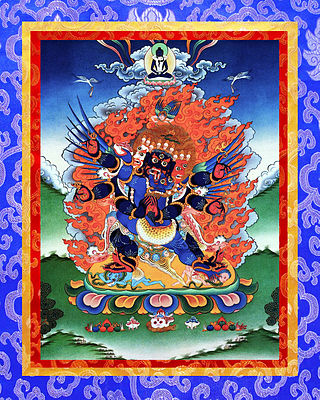
In Tibetan Buddhism, Vajrakilaya or Vajrakumara is a wrathful heruka yidam deity who embodies the enlightened activity of all the Buddhas. His practice is known for being the most powerful for removing obstacles and destroying the forces hostile to compassion. Vajrakilaya is one of the eight deities of Kagyé.

A kapala is a skull cup used as a ritual implement (bowl) in both Hindu Tantra and Buddhist Tantra (Vajrayana). Especially in Tibet, they are often carved or elaborately mounted with precious metals and jewels.

A Yamari is a yidam or meditation deity of the Anuttara Yoga Tantra method (father) classification. The Word यमारि yamāri in Sanskrit means Yama's Enemy There are three types of Yamari:
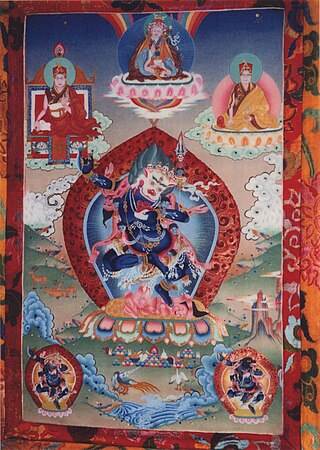
In Tibetan Buddhism, Siṃhamukhā or Siṃhavaktra, also known as the Lion Face Dakini or Lion-headed Dakini, is a wisdom dakini of the Dzogchen tradition. She is represented as a fierce dakini with the head of a snow lion. Her mouth is depicted with a roar, symbolizing untamed fury and jubilant laughter. Her roar disperses discursive thoughts. She is naked, symbolizing that she herself is completely free of discursive thought.



















